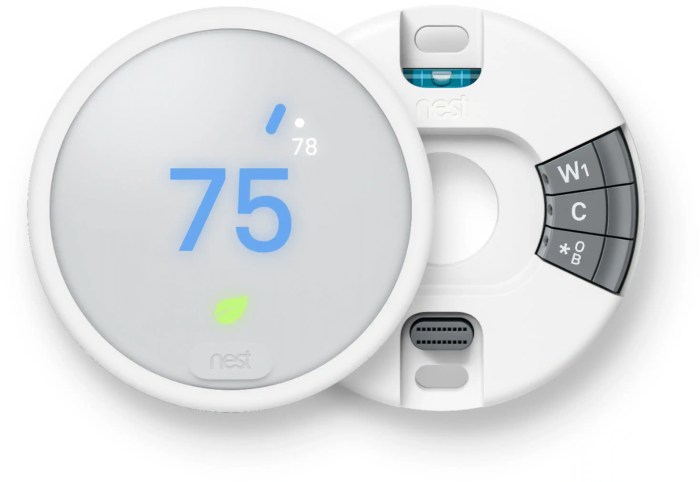The Best Buy Guide for Smart Thermostats: Find Your Ideal Choice

Embark on a journey to discover the world of smart thermostats at Best Buy, where innovation meets convenience. Learn about the latest trends and features that make these devices a must-have for modern homes.
Explore the benefits, key considerations, and user experiences that will help you make an informed decision when choosing the perfect smart thermostat for your needs.
Introduction to Smart Thermostats
Smart thermostats are innovative devices that are designed to regulate the temperature of your home more efficiently and conveniently. Unlike traditional thermostats, smart thermostats can be controlled remotely using your smartphone or other smart devices.
One of the key differences between smart thermostats and traditional thermostats is their ability to learn your habits and preferences over time, adjusting the temperature automatically to optimize energy usage and comfort. This feature helps you save money on your energy bills while ensuring that your home is always at the perfect temperature.
Benefits of Using a Smart Thermostat
- Energy Savings: Smart thermostats can help reduce your energy consumption by automatically adjusting the temperature when you're away or asleep.
- Convenience: Control your thermostat from anywhere using your smartphone, voice commands, or through a smart home system.
- Customization: Set schedules, create heating or cooling zones, and personalize settings to fit your lifestyle.
Popular Smart Thermostat Brands Available at Best Buy
- Nest
- Ecobee
- Honeywell
Features to Consider
When choosing a smart thermostat, there are key features that you should consider to ensure it meets your needs and integrates well with your home.
Connectivity Options
- Wi-Fi: A Wi-Fi-enabled smart thermostat allows you to control and monitor your home's temperature remotely through a smartphone app or web portal.
- Bluetooth: Some smart thermostats use Bluetooth connectivity for short-range communication, which can be useful for pairing with other devices in your home.
Compatibility with Smart Home Systems
- Alexa: Look for a smart thermostat that is compatible with Amazon Alexa, allowing you to control your thermostat using voice commands.
- Google Assistant: Ensure compatibility with Google Assistant for voice control and integration with other smart devices in your home.
- Apple HomeKit: If you use Apple products, consider a smart thermostat that works with Apple HomeKit for seamless integration with your existing smart home ecosystem.
Energy-Saving Features
- Geofencing: Smart thermostats with geofencing technology can detect when you are away from home and adjust the temperature accordingly, helping to save energy.
- Learning Algorithms: Some smart thermostats use advanced algorithms to learn your schedule and temperature preferences, automatically adjusting settings for optimal comfort and energy efficiency.
Installation and Setup

Installing and setting up a smart thermostat is crucial to ensure optimal performance and energy savings in your home.
Installation Process
- Turn off power: Before starting the installation process, make sure to turn off the power to your HVAC system at the circuit breaker to avoid any electrical mishaps.
- Remove old thermostat: Carefully remove your old thermostat from the wall, taking note of the wires and their corresponding labels.
- Mount new thermostat: Follow the manufacturer's instructions to mount the new smart thermostat on the wall, ensuring it is level and securely attached.
- Connect wires: Connect the labeled wires from your HVAC system to the corresponding terminals on the smart thermostat.
- Power on: Turn the power back on at the circuit breaker and follow the setup instructions provided by the manufacturer to configure your smart thermostat.
DIY vs Professional Installation
- DIY installation: DIY installation is possible for those comfortable working with electrical systems and following instructions. It can save money but may void warranties if not done correctly.
- Professional installation: Hiring a professional ensures proper installation and setup, minimizing the risk of errors and ensuring optimal performance. It may come at an additional cost but provides peace of mind.
Troubleshooting Tips
- Check power source: Ensure the smart thermostat is receiving power and properly connected to the HVAC system.
- Verify wiring: Double-check the wiring connections to make sure they are secure and correctly placed in the terminals.
- Update firmware: Check for firmware updates and install them to ensure the smart thermostat is running the latest software version.
- Reset settings: If issues persist, try resetting the smart thermostat to factory settings and reconfigure it from scratch.
Setting Up and Configuring
- Program schedules: Set up heating and cooling schedules based on your daily routine to maximize energy efficiency.
- Adjust settings: Customize temperature settings and preferences to suit your comfort levels and save on energy costs.
- Connect to Wi-Fi: Connect the smart thermostat to your home Wi-Fi network to enable remote access and control via a smartphone app.
- Utilize smart features: Explore additional features like geofencing, learning algorithms, and energy reports to optimize your HVAC system's performance.
User Experience and Interface
Smart thermostats offer a user-friendly interface that allows homeowners to easily control and monitor their heating and cooling systems.
User Interface of Smart Thermostats
Smart thermostats typically come with sleek touchscreen displays that provide an intuitive way for users to adjust settings. Some models even offer voice control options for hands-free operation.
Controlling and Monitoring Remotely
Users can control and monitor their smart thermostats remotely through dedicated mobile apps or web portals. This feature enables homeowners to adjust temperature settings, view energy usage data, and receive alerts from anywhere with an internet connection.
Convenience of Scheduling Temperature Changes
One of the key benefits of smart thermostats is the ability to schedule temperature changes throughout the day. Users can create custom heating and cooling schedules based on their daily routines, helping them save energy and maintain comfort without manual adjustments.
User Feedback and Reviews
Popular smart thermostat models like Nest, Ecobee, and Honeywell have received positive feedback from users for their ease of use, energy-saving features, and compatibility with smart home systems. Many users appreciate the convenience of remote access and the ability to monitor and control their HVAC systems efficiently.
Closing Notes
As we conclude our discussion on smart thermostats available at Best Buy, remember to prioritize your comfort, energy efficiency, and convenience. Make the smart choice today for a smarter tomorrow.
Commonly Asked Questions
What are the key features to consider when choosing a smart thermostat?
Consider features like programmable scheduling, energy usage reports, compatibility with smart home systems, and ease of use.
Can I install a smart thermostat myself?
Yes, most smart thermostats come with DIY installation guides, but professional installation is recommended for complex systems.
How do smart thermostats help in saving energy?
Smart thermostats utilize technologies like geofencing and learning algorithms to optimize temperature settings and reduce energy consumption.
Which smart home systems are compatible with smart thermostats?
Popular smart thermostat brands often integrate with systems like Alexa, Google Assistant, and Apple HomeKit for seamless control.
What is the user interface like for smart thermostats?
Most smart thermostats have user-friendly interfaces that allow users to easily adjust settings and monitor temperature remotely.




